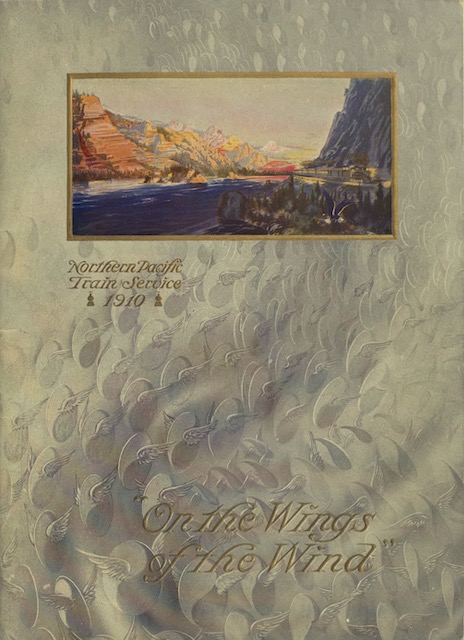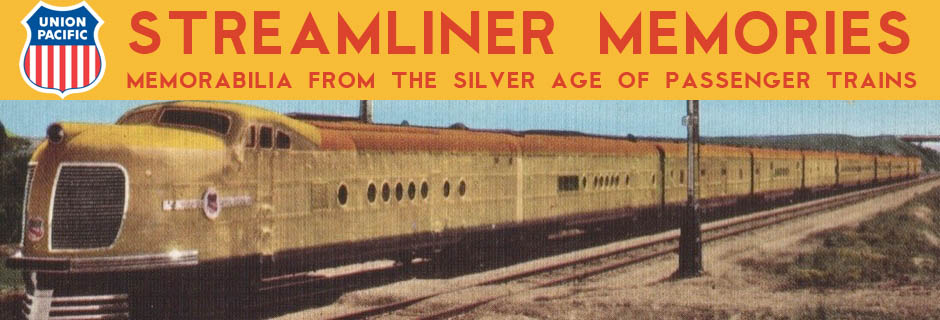Instead of being about Yellowstone, Lewis & Clark, or hunting mountain goats, this 1910 Northern Pacific booklet is about the railway’s passenger trains. At the time, NP operated four daily St. Paul-Seattle trains and one train between St. Louis (via the Burlington) and Tacoma.
 Click image to download a 10.1-MB PDF of this 40-page booklet.
Click image to download a 10.1-MB PDF of this 40-page booklet.
This booklet was issued during one of the two brief periods that the North Coast Limited was an all-Pullman train, meaning no tourist sleepers or coaches. It was backed up by the Northern Pacific Express (eastbound called the Atlantic Express), which at the time was NP’s only train that went through to Chicago via the Burlington. It carried day coaches and tourist as well as Pullman sleepers and an observation-library-buffet car for the benefit of the Pullman passengers.
Somewhat lower in prestige were the Western Express and Eastern Express, which carried similar equipment to the Northern Pacific Express except with a smoking car (usually the first car on the train and partly a baggage car) in place of the observation car.
Least prestigious were the Pacific Coast-Twin City Expresses, which carried sleeping cars between Duluth and Tacoma and both Pullman and tourist cars between St. Paul and Spokane, but anyone going from St. Paul to the Puget Sound had to change cars in Spokane. The train had a smoking car but no observation car. The Puget Sound Express, which went between St. Louis and Seattle, carried Pullmans, tourist sleepers, and coaches, but there is no mention of an observation or smoking car.
NP was proud of its dining car service and all four trains, plus Seattle-Spokane, Portland-Vancouver, and Duluth-Minneapolis trains all carried diners. NP owned a poultry and dairy farm in Kent, Washington supplying all of the eggs served on board the trains and 300 dairy cows to supply all the milk and cream for passengers. Bakeries in Seattle and St. Paul made all the bread, cakes, pies, and pastries served on board the trains.
The title page compared “the past and the present,” the former being a 4-4-0 locomotive dressed up to go to NP’s Golden Spike ceremony in 1883 and the latter represented by a vintage 1909 4-6-2 passenger locomotive and 1907 2-8-8-2 steam locomotive. Both of these “gigantic” locomotives would soon be dwarfed by 4-8-4 passenger and 2-8-8-2 and 2-8-8-4 freight locomotives that NP would introduce before 1930.
Most of the remaining pages have a small photo and text placed over one of eight backgrounds that rotate through the booklet. First is a mountain that I don’t recognize but looks a little like Grinnell Peak in Glacier Park (but can’t be because NP didn’t go there). Second is the Minnesota state capitol building in St. Paul juxtaposed next to a waterfall, possibly meant to represent St. Anthony Falls.
Next come three scenes from Yellowstone: Old Faithful Inn, the Roosevelt Arch in Gardiner, and the half-bridge south of Mammoth Hot Springs known as the Golden Gate. The sixth is NP’s Livingston station, where locomotives were traditionally changed and passengers changed trains to go to Yellowstone. Finally, there were two pictures with different views of the Cape Horn Tunnel on semi-subsidiary Spokane, Portland & Seattle. To allow enough space for each of these pictures to be recognizable, the text and photo occupied only about 40 percent of each page.
This booklet is available on archive.org. I removed the library marks and cleaned up the pages a bit. However, archive.org’s PDF file is smaller (about 2.5 MB), so if you have a slow connection or limited disk space, you might want to download that one.
